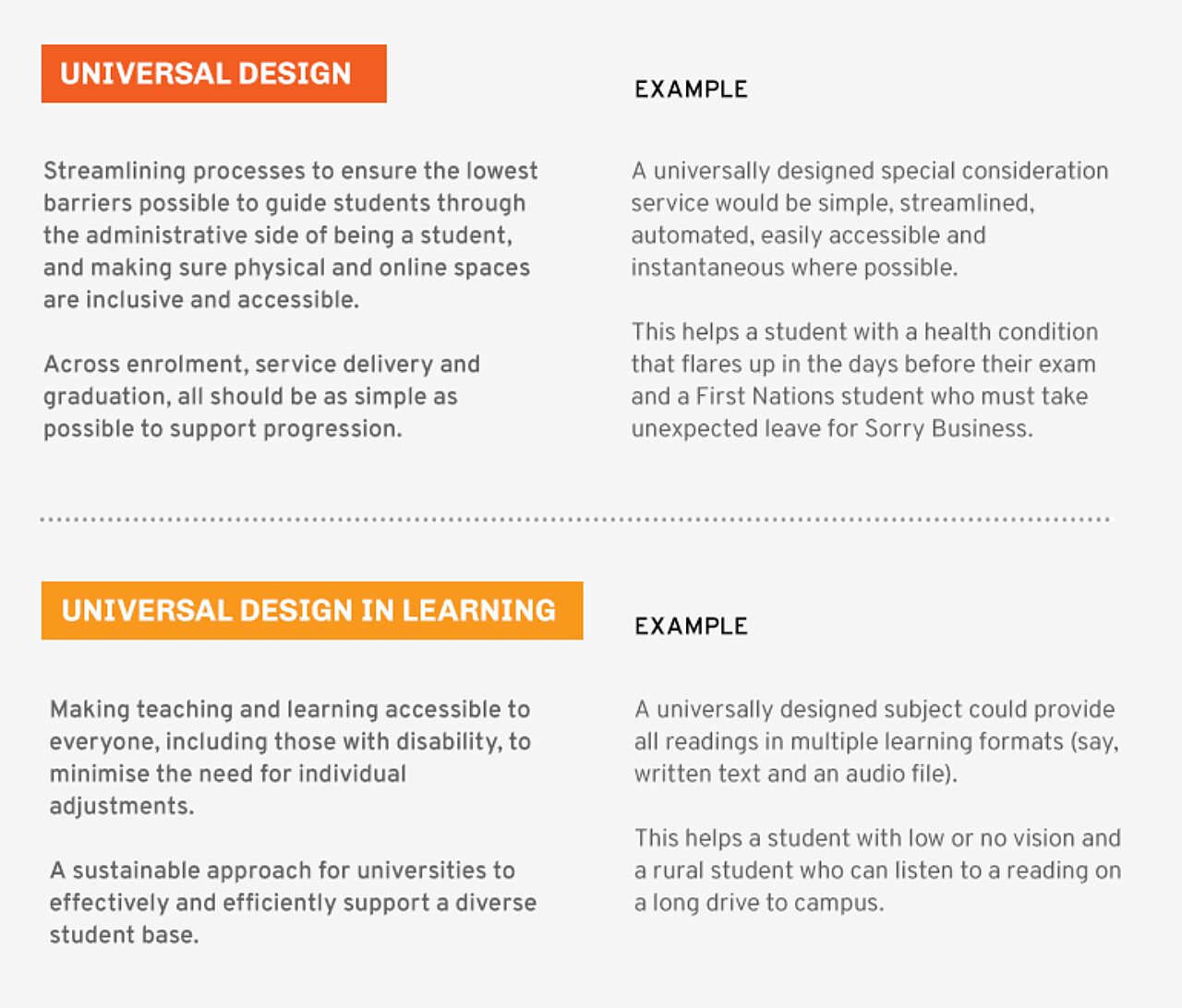Idea In Brief
Real challenge
Universities face a real challenge in engaging and retaining students from underrepresented backgrounds amid an uncertain funding environment. So how can universities prepare for a new era of participation?
Universal design
While there are many ways to improve inclusion for underrepresented students, one method is proven to engage and include students and support institutional efficiency: universal design (UD).
UD in practice
Universities should consider UD strategies for success: Consider the future of participation; Identify barriers to learning; Pilot UD and UDL; Define your equitable participation strategy; Take a whole-of-university approach.
Universities face a real challenge in engaging and retaining students from underrepresented backgrounds amid an uncertain funding environment. So how can universities prepare for a new era of participation?
From our experience working with universities in several countries, the answer lies in universal design of university campuses, services and pedagogy.
Australia is entering a new era of higher education participation
Universities have been striving to meet this challenge for decades with mixed results, but the Australian Universities Accord released in February creates renewed urgency for outcomes, not simply good intentions.
The Accord calls for equity of participation and putting students at the centre of the sector. In particular, the report proposes a focus on four under-represented groups: people from low SES backgrounds, First Nations, people with a disability, and regional and remote students. It calls for their participation at a rate proportional to the rest of the population.
Achieving parity by 2050 will not be easy
The Accord acknowledges that supporting students from target groups is more resource-intensive and traditionally under-funded by government and calls for needs-based funding. Attracting and accommodating students with different wants, needs and life experiences requires capacity and capability many universities simply do not have.
Even in the case of students living with a disability, where the Accord calls for maintaining current participation rates, universities are under pressure. Research shows that universities are already spending on average $1.3 million every year on disability student support. Universities we work with report that increasing volume and complexity of student requests comes from neurodivergent students and students living with a mental or chronic health condition, two groups not included in the Accord’s definition of disability.
Demand from these groups is expected to increase given 250,000 NDIS participants under 25 live with a primary disability in the psychosocial, autism or intellectual category, most of whom will enter the undergraduate age group in the coming 15 years.
This means that, regardless of the target for participation of people living with disability in higher education, universities will see an increase in the volume and complexity of student support needs in this area. Add to this pressure from the Accord to attract more students from low SES, First Nations, rural and remote backgrounds, and universities must start thinking differently.
Universal design is central to making these ambitions a reality
While there are many ways to improve inclusion for underrepresented students, there is one method that is proven to engage and include students and support institutional efficiency: universal design (UD), including universal design in learning (UDL).
The UD approach promotes inclusion and accessibility by considering the needs of all students at the design phase, minimising the need for individual adjustments. It lowers barriers for participation and makes physical spaces, administrative processes and learning experiences more accessible, not just for people with disability, but for all target groups identified in the Accord.


The benefits for student experience, success and safety are clear. UD embeds inclusion in the university experience, most of which is in-classroom education. Lower barriers to education enable students of varied backgrounds to balance education with all elements of their personal and cultural lives. This leads to better retention, fewer service interventions, and fewer student complaints; a welcome benefit as the Australian Government considers the Accord’s proposal for a National Student Ombudsman.
Welcoming more students with a greater diversity of needs requires a higher baseline of inclusion for universities to remain sustainable.
It's time for universities to act
Universities that can deliver sustainable, high-quality support to students from equity groups will seize the opportunity to recruit and retain students. Those that continue delivering unsustainable models will fight a losing battle on student experience and success, with negative implications for recruitment, retention, brand, and funding.
Universities should consider UD-led strategies for success:
- Consider the future of participation. Plan for the future student base by assessing market demand and the university’s strategy. Identify the student groups the university will actively recruit and engage with students from those groups to understand their experience and their needs to inform the design of campuses, services and pedagogy. (We have previously identified five strategies for elevating the student voice to ensure you are delivering on your student value proposition.)
- Identify barriers to learning and opportunities to use UD and UDL. Most universities will need to thoughtfully look at their campuses, services and pedagogy to determine current barriers, and the greatest opportunities for UD and UDL. To truly design universally, universities must consider this in every element of the operating model. (We have previously presented a case study on redesigning mental health services to increase access with the University of Alberta.)
- Pilot UD and UDL where possible. Any practical improvement on UD and UDL makes a difference for students from underrepresented groups. Where needed, start small with pilot programs to design or re-design pedagogy and services. As UD and UDL scales up over time, institutions continually grow their readiness to recruit and support students from underrepresented groups. (We have previously explored how a sprint approach can enable universities to make valuable change for students quickly.)
- Define your equitable participation strategy. Collaboratively develop a pragmatic and practical plan for embedding inclusive practice, including UD and UDL across the university. Success for such a strategy depends on alignment with the university strategy and any student recruitment and enrolment strategies. (We have previously identified five actions for designing for people who are systemically overlooked.)
- Take a whole-of-university approach. Open the conversation on how your university can practically support students from underrepresented groups to all players in the university system, including students, student services staff, and academic and teaching staff. (We have previously explored how co-design can be used to actively engage perspectives from across a university.)
We worked with an Go8 university to design a sustainable disability supports model
We have been fortunate to work with a Group of Eight (Go8) university on this challenge.
The university was experiencing a steep increase in student requests for disability support services: the number of students needing academic adjustments grew by 12.5 per cent annually for over a decade. This created workload challenges at peak periods for both disability advisers in designing access plans and academic staff in delivering them. The university wanted to see this process made easier for staff, students and academic teaching staff, and engaged us to build a benchmarking dataset for disability supports in Australia and the UK.
We engaged university stakeholders across the ecosystem to assess the current state and seek opportunities for improvements. We then gathered data from seven other universities in Australia and the UK to understand commonalities and differences in operating models and current practice.
It was clear from our research that a long-term sustainable disability supports model relies on several enablers across service delivery and learning design. We were able to provide the university a sector-wide view of current practice and identify opportunities to prepare for further increases in students living with a disability or health condition.
The university now has a view to the future of disability support, even as numbers increase. The project helped build has buy-in across the ecosystem to improve disability supports services and investigate universal design for an increasingly diverse student base.
An uncertain funding environment requires a pragmatic and efficient response
How the government will respond the Accord’s recommendation for needs-based funding is unknown. For universities with comparatively low participation rates, funding will not increase until they have made considerable progress. Improving access and attainment at scale will require universities to re-think individual student support and their approach to teaching and learning. Intentional investment in UD and UDL now will allow universities to reap the benefits of the new funding model once in place.
For the institution, the most significant benefit of universal design in student services and learning is the improved financial sustainability. Where learning is inclusive by default, students have fewer requests for student services like academic adjustments, learning support, and even mental health supports. UD and UDL free up capacity for professional and academic staff by providing a more inclusive experience for all students.
In other words, UD and UDL is the efficiency measure that universities need to grow. It should be on the agenda of every Deputy Vice Chancellor (Education and Academic) in the country.
Get in touch to explore how we can support you to implement universal design at your university.
Connect with Tess Lawley and Mia Juritzen on LinkedIn.
Prepared with input from Paul Taylor and Trisha Santhanam.

